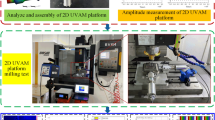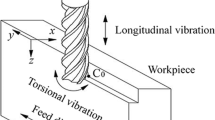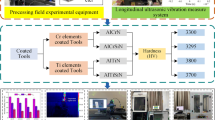Abstract
Ti2AlNb has much application potential in the aerospace sector thanks to its outstanding material characteristics. Poor wear resistance, however, blocks its development. This study used LTUAM (longitudinal-torsional ultrasonic-assisted milling) to get the surface micro-texture of Ti2AlNb in order to address the issue. By comparing traditional milling (CM), the surface micro-texture and tribological characteristics were studied. On this basis, the kinematic characteristics of the elliptical vibration were explored, introducing the critical condition of the separated pattern. In addition, the torsion-rotation ratio was put forward to understand the separation characteristics. The corresponding finite element model exhibited these kinematic characteristics. The model also looked into how the cutting parameters affected the way surface microtexture was generated. Experimental results indicated that machined surfaces with uniform micro-texture were seen in LTUAM, whereas scratches predominated in CM. The variation of micro-texture and surface roughness was discussed in respect to cutting parameters. It has been demonstrated that a machined surface with uniform micro-texture had superior tribological properties. The friction coefficient under LTUAM was approximately 27.08% less than that in CM.

















Similar content being viewed by others
Data availability
The datasets analyzed during the current study are available from the corresponding author on reasonable request.
References
Zhang HY, Yan N, Liang HY, Liu YC (2021) Phase transformation and microstructure control of Ti2AlNb-based alloys: a review. J Mater Sci Technol 80:203–216. https://doi.org/10.1016/j.jmst.2020.11.022
Gao GF, Fu ZX, Wang Y, Xiang DH, Zhao B (2021) Research progress on precision machining of Ti-Al intermetallic compounds. Rare Metal Mat Eng 50(5):1867–1882
Kumpfert J (2001) Intermetallic alloys based on orthorhombic titanium aluminide. Adv Eng Mater 3(11):851–864. https://doi.org/10.1002/1527-2648(200111)3:11%3c851::AID-ADEM851%3e3.0.CO;2-G
Hua K, Wan Q, Tong YL, Yang G, Wu HX, Zhou Q, Wang HF (2021) Microstructural feature dependence of dry sliding wear behaviors in a γ-TiAl alloy. Wear 484:204039. https://doi.org/10.1016/j.wear.2021.204039
Zou HB, Yan S, Shen T, Wang HJ, Li Y, Chen JY, Meng YQ, Men SC, Zhang ZJ, Sui TY, Lin B (2021) Efficiency of surface texturing in the reducing of wear for tests starting with initial point contact. Wear 482:203957. https://doi.org/10.1016/j.wear.2021.203957
Li S, Zhang N, Yang ZH, Li X, Zhao G, Wang TM, Wang QH, Zhang XR (2019) Tailoring friction interface with surface texture for high-performance ultrasonic motor friction materials. Tribol Int 136:412–420. https://doi.org/10.1016/j.triboint.2019.03.072
Etsion I (2005) State of the art in laser surface texturing. J Tribol-T Asme 127(1):248–253. https://doi.org/10.1115/1.1828070
Costa HL, Hutchings IM (2009) Development of a maskless electrochemical texturing method. J Mater Process Tech 209(8):3869–3878. https://doi.org/10.1016/j.jmatprotec.2008.09.004
Hua M, Tam HY, Ma HY, Mok CK (2006) Patterned PVD TiN spot coatings on M2 steel: tribological behaviors under different sliding speeds. Wear 260(11):1153–1165. https://doi.org/10.1016/j.wear.2005.07.014
Zhu LD, Ni CB, Yang ZC, Liu CF (2019) Investigations of micro-textured surface generation mechanism and tribological properties in ultrasonic vibration-assisted milling of Ti–6Al–4V. Precis Eng 57:229–243. https://doi.org/10.1016/j.precisioneng.2019.04.010
Liu XF, Zhang JH, Hu XY, Wu DB (2019) Influence of tool material and geometry on micro-textured surface in radial ultrasonic vibration-assisted turning. Int J Mech Sci 152:545–557. https://doi.org/10.1016/j.ijmecsci.2019.01.027
Amini S, Hosseinabadi HN, Sajjady SA (2016) Experimental study on effect of micro textured surfaces generated by ultrasonic vibration assisted face turning on friction and wear performance. Appl Surf Sci 390:633–648. https://doi.org/10.1016/j.apsusc.2016.07.064
Yang ZC, Zhu LD, Zhang GX, Ni CB, Lin B (2020) Review of ultrasonic vibration-assisted machining in advanced materials. Int J Mach Tool Manu 156:103594. https://doi.org/10.1016/j.ijmachtools.2020.103594
Chen F, Bie WB, Wang XB, Zhao B (2022) Longitudinal-torsional coupled rotary ultrasonic machining of ZrO2 ceramics: an experimental study. Ceram Int 48(19):28154–28162. https://doi.org/10.1016/j.ceramint.2022.05.398
Gao GF, Xia ZW, Yuan ZJ, Xiang DH, Zhao B (2021) Influence of longitudinal-torsional ultrasonic-assisted vibration on micro-hole drilling Ti-6Al-4V. Chinese J Aeronaut 34(9):247–260. https://doi.org/10.1016/j.cja.2020.06.012
Liu YH, Geng DX, Shao ZY, Zhou ZH, Jiang XG, Zhang DY (2021) A study on strengthening and machining integrated ultrasonic peening drilling of Ti-6Al-4V. Mater Design 212:110238. https://doi.org/10.1016/j.matdes.2021.110238
Peng ZL, Zhang XY, Zhang DY (2021) Performance evaluation of high-speed ultrasonic vibration cutting for improving machinability of Inconel 718 with coated carbide tools. Tribol Int 155:106. https://doi.org/10.1016/j.triboint.2020.106766
Zhang ML, Zhang DY, Geng DX, Shao ZY, Liu YH, Jiang XG (2020) Effects of tool vibration on surface integrity in rotary ultrasonic elliptical end milling of Ti–6Al–4V. J Alloy Compd 821:153266. https://doi.org/10.1016/j.jallcom.2019.153266
Xi XX, Yu TY, Ding WF, Xu JH (2018) Grinding of Ti2AlNb intermetallics using silicon carbide and alumina abrasive wheels: tool surface topology effect on grinding force and ground surface quality. Precis Eng 53:134–145. https://doi.org/10.1016/j.precisioneng.2018.03.007
Wang B, Liu ZQ, Cai YK, Luo XC, Ma HF, Song QH, Xiong ZH (2021) Advancements in material removal mechanism and surface integrity of high speed metal cutting: a review. Int J Mach Tool Manu 166:103744. https://doi.org/10.1016/j.ijmachtools.2021.103744
He LJ, Su HH, Xu JH, Zhang L (2018) Inverse identification of constitutive parameters of Ti2AlNb intermetallic alloys based on cooperative particle swarm optimization. Chinese J Aeronaut 31(8):1774–1785. https://doi.org/10.1016/j.cja.2018.01.002
Xi XX, Ding WF, Fu YC, Xu JH (2018) Grindability evaluation and tool wear during grinding of Ti2AlNb intermetallics. Int J Adv Manuf Tech 94(1–4):1441–1450. https://doi.org/10.1007/s00170-017-1005-7
Sim KH, Zhang FH, Wang GF, Rao XS (2018) Experimental comparison of ground surface characteristics for P/M Ti2AlNb-based alloy using CBN and diamond grinding wheels. Int J Adv Manuf Tech 94(5–8):1885–1894. https://doi.org/10.1007/s00170-017-0900-2
Yuan ZJ, Gao GF, Wang Y, Fu ZX, Xiang DH (2022) Correction to: Experimental study on a two-dimensional ultrasonic vibration platform and milling of Ti2AlNb intermetallic alloy. Int J Adv Manuf Tech 122(5):2793–2793. https://doi.org/10.1007/s00170-022-10130-5
Bhaduri D, Soo SL, Aspinwall DK, Novovic D, Bohr S, Harden P, Webster JA (2017) Ultrasonic assisted creep feed grinding of gamma titanium aluminide using conventional and superabrasive wheels. Cirp Ann-Manuf Techn 66(1):341–344. https://doi.org/10.1016/j.cirp.2017.04.085
Buchkremer S, Wu B, Lung D, Münstermann S, Klocke F, Bleck W (2014) FE-simulation of machining processes with a new material model. J Mater Process Tech 214(3):599–611. https://doi.org/10.1016/j.jmatprotec.2013.10.014
Zhao B, Guo XC, Bie WB, Chang BQ, Zhao CY (2020) Thermo-mechanical coupling effect on surface residual stress during ultrasonic vibration-assisted forming grinding gear. J Manuf Process 59:19–32. https://doi.org/10.1016/j.jmapro.2020.09.041
Mahnama M, Movahhedy MR (2012) Application of FEM simulation of chip formation to stability analysis in orthogonal cutting process. J Manuf Process 14(3):188–194. https://doi.org/10.1016/j.jmapro.2011.12.007
Xu J, He L, Su H, Zhang L (2018) Tool wear investigation in high-pressure jet coolant assisted machining Ti2AlNb intermetallic alloys based on FEM. Int J Light Mater Manuf 1(4):219–228. https://doi.org/10.1016/j.ijlmm.2018.08.007
Bai W, Wang K, Du DX, Zhang JG, Huang W, Xu JF (2022) Design of an ultrasonic elliptical vibration device with two stationary points for ultra-precision cutting. Ultrasonics 120:106662. https://doi.org/10.1016/j.ultras.2021.106662
Jung HJ, Hayasaka T, Shamoto E, Xu LJ (2020) Suppression of forced vibration due to chip segmentation in ultrasonic elliptical vibration cutting of titanium alloy Ti–6Al–4V. Precis Eng 64:98–107. https://doi.org/10.1016/j.precisioneng.2020.03.017
Li X, Zhang DY (2010) Experimental study on the unseparated ultrasonic elliptical vibration cutting. Chin J Mech Eng-En 46(19):177–182. https://doi.org/10.3901/JME.2010.19.177
Zhao B, Bie WB, Wang XB, Chang BQ (2020) Design and experimental investigation on vibration system of longitudinal-torsional ultrasonic drilling TC4 titanium alloy. Acta Aeronautica et Astronautica Sinica 41(1):291–303. https://doi.org/10.7527/S1000-6893.2019.23207
Acknowledgements
The authors deeply acknowledge the Key Laboratory of High Performance Manufacturing for Aero Engine (Northwestern Polytechnical University) and Engineering Research Center of Advanced Manufacturing Technology for Aero Engine (Northwestern Polytechnical University) for providing us with the ability to conduct this research.
Funding
This work was co-supported by the National Natural Science Foundation of China (Nos. 91960203 and 51875473), and the Science Center for Gas Turbine Project (P2022-A-IV-001–002).
Author information
Authors and Affiliations
Contributions
Ziwen Xia: methodology, validation, data curation, writing — original draft. Guofu Gao: conceptualization, methodology, software, writing — original draft. Yi Wang: visualization, investigation. Menghua Zhang: visualization, investigation. Fangchao Jia: conceptualization, methodology, supervision. Chenwei Shan: supervision, funding acquisition, writing — review and editing.
Corresponding author
Ethics declarations
Ethics approval
This paper does not include any research conducted by any author with humans or animals as participants.
Competing interests
The authors declare no competing interests.
Consent to participate
Not applicable.
Consent for publication
Not applicable.
Additional information
Publisher's note
Springer Nature remains neutral with regard to jurisdictional claims in published maps and institutional affiliations.
Rights and permissions
Springer Nature or its licensor (e.g. a society or other partner) holds exclusive rights to this article under a publishing agreement with the author(s) or other rightsholder(s); author self-archiving of the accepted manuscript version of this article is solely governed by the terms of such publishing agreement and applicable law.
About this article
Cite this article
Xia, Z., Gao, G., Wang, Y. et al. Surface micro-texture and tribological properties in longitudinal-torsional ultrasonic-assisted milling Ti2AlNb. Int J Adv Manuf Technol 126, 1919–1935 (2023). https://doi.org/10.1007/s00170-023-11211-9
Received:
Accepted:
Published:
Issue Date:
DOI: https://doi.org/10.1007/s00170-023-11211-9




